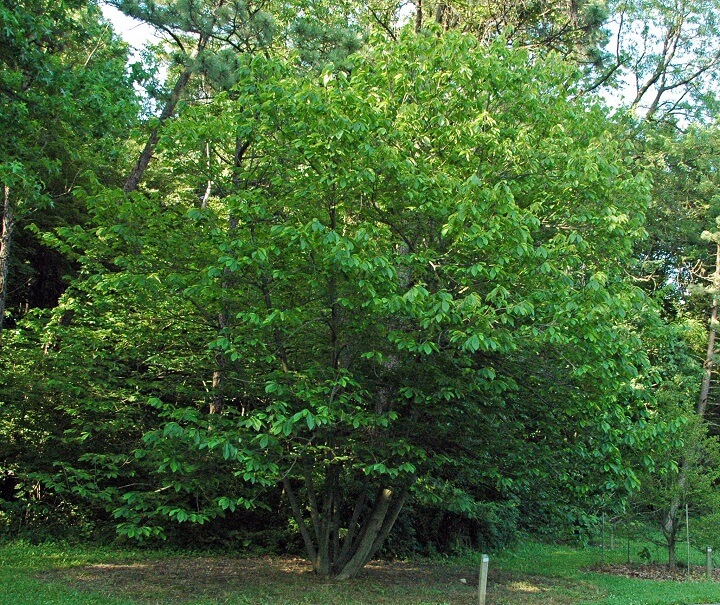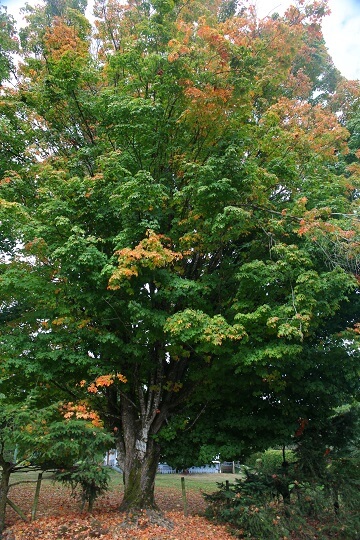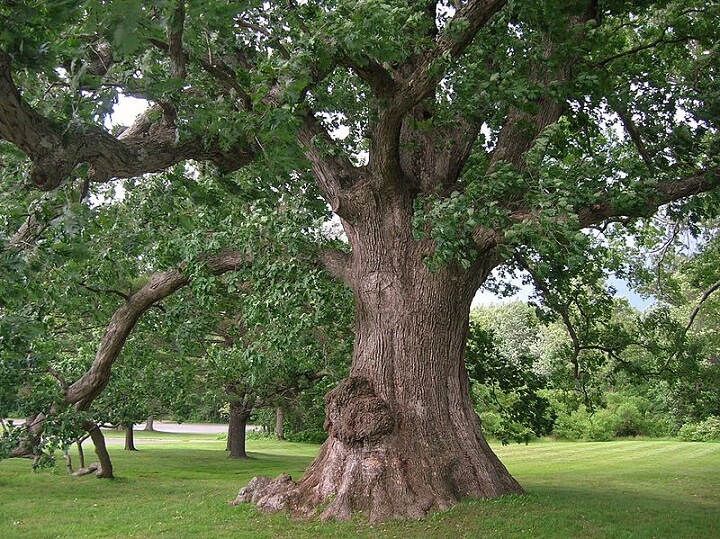[ad_1]
Estimated studying time: 12 minutes

In the case of preparedness, we regularly take into consideration the gadgets we have to buy and stockpile. We could not take into account what’s rising proper on our personal property or inside a brief distance. Bushes not solely present oxygen, shade, and firewood, however additionally they supply many different advantages. Realizing about them might save your life in an emergency.
So, get out your tree identification information in case you want one, and find out about these seven timber each survivalist
ought to know.
Wish to save this publish for later? Click on Right here to Pin It On Pinterest!
American Basswood

The American basswood (additionally referred to as the American linden) is frequent to the japanese United States and sometimes grows close to creeks, streams, and ponds. Basswoods have massive, toothed leaves. A leaf that’s formed like a tongue emerges on the base of the common heart-shaped leaves on mature basswoods. Small, nut-like fruits grasp from these “tongue” leaves through the summer season months.
American Basswood Survival Suggestions:
The internal fibers of basswood bark will be twisted right into a sturdy rope.Basswood leaves are edible and are particularly flavorful within the spring.The tree’s internal bark layer is also edible and has a candy style.Basswood is delicate and is helpful as friction firewood.It additionally is straightforward to carve.
Black Walnut

The Black Walnut, with its strong, darkish bark and enormous, compound leaves, is a treasure trove for the survivalist. Native to the japanese United States, this tree is famend for its invaluable hardwood and nutritious nuts. Its spherical, inexperienced fruits include a tough, brown nut inside, which is encased in a thick husk.
Black Walnut Survival Suggestions:
Black Walnut nuts are wealthy in vitamins and supply important fat and protein. Cracking the laborious shell could require a rock or hammer, however the effort yields a tasty and calorie-dense reward.The husks of Black Walnut can be utilized to make a pure dye or stain, which might be helpful for camouflage or marking gadgets.The wooden of the Black Walnut tree is extremely robust and immune to decay, making it excellent for setting up sturdy survival instruments, shelters, or crafting bows and arrows.Warning needs to be exercised when accumulating nuts or dealing with the leaves, because the tree produces juglone, a compound that may be poisonous to different crops. This attribute makes Black Walnut helpful for creating a fringe round a campsite to discourage the expansion of different vegetation.In a medicinal pinch, the internal bark of the Black Walnut tree will be brewed right into a tea believed to have antiseptic and anti-parasitic properties, although this needs to be used with warning and data of correct preparation.
Douglas Fir

The Douglas fir, prevalent within the Pacific Northwest, stands tall amongst its coniferous brethren. Recognizable by its thick, ridged bark and delicate, flat needles that spiral across the department, the Douglas fir will not be a real fir however a member of the pine household. Its cones are distinctive, with bracts protruding from beneath the scales, resembling the again half of a mouse diving into hiding.
Douglas Fir Survival Suggestions:
The internal bark of the Douglas fir is edible and will be dried and floor into flour or eaten uncooked in survival conditions.Douglas fir needles will be brewed right into a tea that’s excessive in Vitamin C, very like the white pine. Merely collect a handful of inexperienced needles, chop them finely, and steep in boiling water for a couple of minutes.The resin from Douglas fir can seal small wounds and cuts because it has antiseptic properties. It may also be used as a waterproofing agent and adhesive.Younger Douglas fir shoots within the spring are tender and edible, offering a refreshing citrus-like taste.
Hickory

Hickory timber, with their laborious, dense wooden and distinctive shaggy bark on some species, are a invaluable useful resource for survivalists. Discovered throughout the japanese United States, hickories produce nuts that aren’t solely scrumptious but additionally filled with energy and vitamins.
Hickory Survival Suggestions:
Hickory nuts will be eaten uncooked or roasted, offering important fat and proteins. The shell could also be robust, however the effort to crack it open is nicely rewarded with the wealthy, buttery nutmeat inside.The wooden of the hickory tree is extremely robust and can be utilized for making sturdy instruments and handles for implements, in addition to for bow-making.Hickory bark will be boiled to extract a syrup or used as a smoking agent for meat resulting from its fragrant properties.The robust, versatile wooden is superb for creating friction fires. A hickory bow drill could be a dependable methodology for fire-starting in survival conditions.
Pawpaw Tree

Discovered within the moist woodlands of the japanese United States, the Pawpaw boasts a tasty mango-like fruit that ripens in mid to late September. Nonetheless, the vitamin-rich fruit is just one of this tree’s advantages.
Pawpaw Survival Suggestions:
Pawpaw bark strips simply and separates into lengthy fibers of that may be twisted to make robust cordage.The tree’s wooden is gentle and simple to carve. Some carvers evaluate pawpaw wooden to balsa or yucca as a result of it’s gentle and porous. Moreover, pawpaw wooden has a fascinating vibrant yellow coloration and a straight grain.
Sugar Maple (and different maples)

Identified for its massive leaves that grow to be vibrant reds and oranges within the fall, the sugar maple provides many survival advantages. Not the least of those is its tasty syrup. Considerable within the japanese woodlands of North American, the sugar maple has leaves with 5 lobes and pointed ideas. Younger maple timber have clean bark that has a silvery coloration.
Sugar Maple Survival Suggestions:
The sap of the sugar maple, which runs in late winter and early spring is a pure vitality drink wealthy in sugar and vitamins.These seeds inside these distinctive helicopters are edible. All it is advisable do is boil them, take away the outer helicopter half after which eat them as is or add them to stir-fries or stews.Younger spring maple leaves are additionally edible. You may boil them as you’d different spring greens or add them to a salad.
White Birch

One of many best timber to establish, the white birch has white, papery bark that peels off in skinny furls. It has small, oval-shaped and toothed leaves which have a pointed tip. The white birch (additionally referred to as the paper birch) is native to the northern a part of North America and is plentiful from Alaska to Maine.
White Birch Survival Suggestions:
The paper-like bark works nicely as a firestarter.The sap is good and drinkable.You can also make a wintergreen-flavored tea by brewing the bark or skinny branches.The fungus that grows nearly solely on the white birch is superb tinder.When heated over a hearth, the tar extracted from the bark make a robust pure adhesive.You may style containers for meals or liquids from the bark.
White Pine (and different pines)
As an evergreen tree, the white pine has needle-like leaves and produces cones quite than flowers. White pines are native to northern central and northeastern North America.
White Pine Survival Suggestions:
The internal layers of the white pine bark are edible.You may boil the needles to make a tea that’s wealthy in Vitamin C. Steep a teaspoonful of chopped pine needles in a cup of sizzling water for 10 minutes.The tree’s resin is flammable and makes a helpful hearth starter when blended with different tinder.Pine needles additionally make glorious hearth gas.You may combine the resin with charcoal to make a robust, waterproof glue.Edible pine nuts come from the cones.Pine needles and pine boughs can be utilized for bedding materials.Pine boughs additionally do nicely as pure insulation in survival shelters.Floor roots of the white pine are pliable and sturdy and will be common into ropes.Pine resin is an insect repellent. Acquire some in a tin container and light-weight it to maintain bugs at bay.The bark of younger pine branches is edible.Younger male pine cones are also edible.
White Oak (and different oak timber)

The majestic white oak tree is native to japanese and central North America. It’s simple to identify oak timber in mid- to late- summer season due to their measurement and all of the acorns they drop. Acorns are extraordinarily helpful in a survival scenario. All acorns have bitter-tasting tannic acid, however it may be eliminated via a easy leaching course of.
White oak acorns are likely to have much less tannic acid than different acorns, and their shell is more durable and simpler to take away than purple acorns. Whereas purple oak timber have pointed leaf lobes, white oaks have leaf lobes which might be rounded.
White Oak Survival Suggestions:
After leaching out the tannic acid, you possibly can grind acorns to make flour. Here’s a video that exhibits this course of for each white acorns and purple oak acorns.Save the tannic acid to make use of as an antiseptic wash.Leached and floor acorns additionally can be utilized as a espresso substitute.Oakwood is agency and laborious and is helpful for a lot of survival functions, together with shelter frameworks, ax handles and shovel sticks.Dried, white oak flowers are helpful as tinder.
Willow Tree

You recognize there’s a water supply close by in case you see a willow tree. Though there are numerous sorts of this sleek tree, all of them desire moist areas. Willow leaves are slim, plentiful and lance-shaped. Native to China, the willow grows all through North America, Europe, and Asia in temperate areas that supply sufficient moisture and daylight.
Willow Survival Suggestions:
Willow bark comprises a pain-relieving chemical referred to as salicin. You may relieve complications and irritation by chewing on just a few small inexperienced willow twigs and swallowing the juices.Willow bark peels away from the wooden simply within the hotter months. You need to use it to make a robust rope.Versatile younger willow branches can be utilized to weave baskets.Dried willow makes a wonderful hearth starter.
Edible Bark
The internal bark of many timber — together with Slippery Elm, most Pines, Black and Yellow Birch, Purple and Black Spruce, Balsam Fir and Tamarack — is a nutritious wild meals supply.
In actual fact, early European explorers reported discovering acres of timber that had been stripped of their bark – proof that Native Individuals generally used bark as meals and drugs. The Adirondack tribe, native to the mountains of upstate New York, means “bark eaters” within the Iroquois language.
The layer of option to devour is named the cambium, and it lies proper subsequent to the wooden. Most internal bark comprises digestible starches, sugar, nutritional vitamins, minerals, and a considerable amount of fiber. Listed here are some examples of how tree bark is used as a meals supply and additive.
Sassafras bark is used to make a conventional Southern tea and a root beer.Hickory nut tree bark will be stripped and boiled right into a syrup that has an earthy, nutty style.Birchbark supplies a candy, wintergreen taste.In some elements of Scandinavia, pine bark is floor right into a powder and utilized in Christmas cookies. Ponderosa pine bark smells like vanilla.
Here’s a detailed video that exhibits find out how to harvest and put together tree bark for consumption
.
Tree Sap
Maples usually are not the one timber which might be good for syrup. You too can use birch, hickory, and black walnut timber for his or her sap, which has a decrease sugar focus than pure maple syrup.
A Phrase Of Warning
Though most tree elements are innocent, correct identification is vital since some have poisonous chemical substances inside them. Additionally, watch out to not strip off a whole ring when harvesting internal bark. Tree bark needs to be thought-about an emergency meals since it could actually stunt the expansion of a tree or kill the tree. Listed here are just a few useful sources to information you.
Sources:
Like this publish? Don’t Neglect to Pin It On Pinterest!

[ad_2]
Source link




